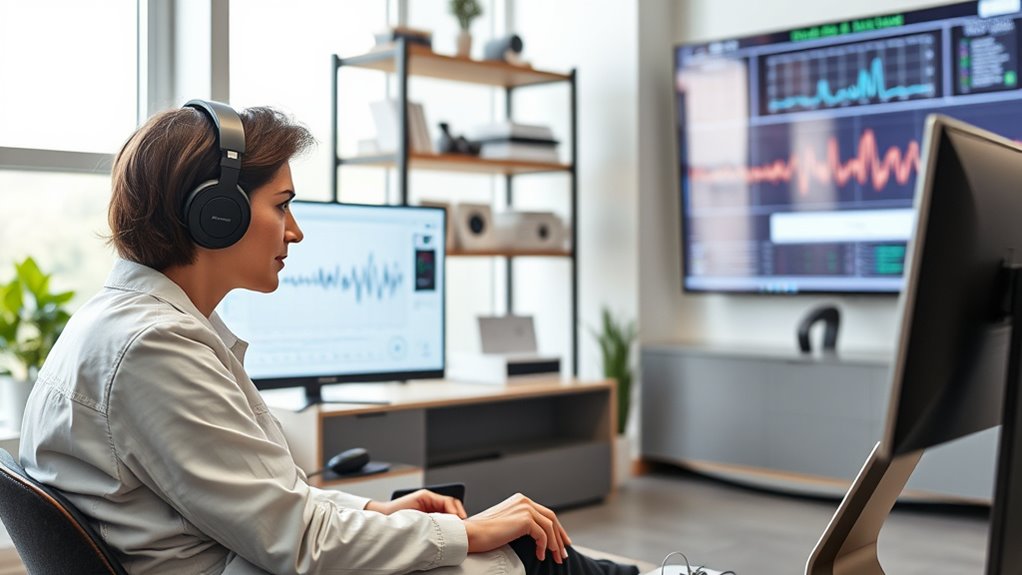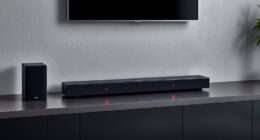Tele-audiology is revolutionizing how you receive hearing care by allowing you to access expert diagnostics, adjustments, and support from the comfort of your home. With remote assessments, modern hearing aids can be fine-tuned wirelessly, and pediatric evaluations become easier for parents and children. Portable devices transmit data instantly, enabling quicker diagnoses and early interventions. If you keep exploring, you’ll discover how these innovations are making hearing care more accessible and convenient than ever before.
Key Takeaways
- Enables remote hearing assessments and consultations, expanding access and reducing the need for in-person visits.
- Supports wireless hearing aid updates and adjustments from afar, enhancing user convenience and device performance.
- Facilitates pediatric evaluations through video-guided screenings, promoting early diagnosis and intervention.
- Utilizes portable diagnostic devices to transmit data securely for rapid interpretation and timely care.
- Offers ongoing remote support and counseling to optimize hearing aid use and ensure sustained patient engagement.

Tele‑audiology is transforming the way hearing care is delivered by enabling remote assessments, consultations, and follow-up services. This shift allows you to access expert care from the comfort of your home, making it easier to address hearing concerns without frequent visits to clinics. One of the key advancements supporting this transformation is the integration of modern hearing aid technology. Many hearing aids now come equipped with wireless connectivity, enabling you to stream sounds directly from devices and receive firmware updates remotely. This means adjustments and troubleshooting can often be handled without in-person visits, saving you time and reducing inconvenience. These features also facilitate remote fine-tuning, ensuring your hearing aids are optimized for your environment, whether you’re at work, home, or out socializing.
When it comes to pediatric assessments, tele-audiology is especially beneficial. If you’re a parent or caregiver, you might worry about getting your child’s hearing evaluated promptly, especially if specialized clinics are far away or have long wait times. Telehealth platforms allow audiologists to guide you through simple screening procedures or observe your child’s responses during diagnostic tests via video calls. This approach reduces stress for your child, who may be more comfortable in familiar surroundings, and accelerates the diagnostic process. Pediatric assessments conducted remotely are often complemented by portable testing devices that transmit data securely to audiologists, who interpret results in real time. This immediacy helps in early detection of hearing impairments, enabling timely intervention that can markedly influence a child’s language development and social skills. Additionally, leveraging robotics expansion in healthcare technology could further enhance remote diagnostic tools, making assessments even more precise and accessible.
Moreover, tele‑audiology extends beyond initial assessments. Follow-up appointments, device troubleshooting, and counseling sessions are now routinely conducted online. This ongoing support is vital, especially for children, because consistent adjustments and encouragement help maximize hearing aid benefits. For parents, it provides reassurance and guidance on managing their child’s hearing devices, fostering better compliance and outcomes. The convenience of remote services also means you can schedule appointments around your busy life, reducing the need to take time off work or travel long distances.
Frequently Asked Questions
How Secure Is Patient Data During Remote Audiology Sessions?
You might wonder how secure patient data is during remote audiology sessions. Rest assured, providers implement strict remote privacy measures to protect your information. They use encrypted connections, secure data storage, and access controls to ensure patient data security. While no system is completely infallible, these measures substantially reduce risks, giving you confidence that your personal information remains private and protected throughout your remote diagnostics.
Can Tele-Audiology Replace In-Person Hearing Assessments Completely?
You wonder if tele-audiology can fully replace in-person hearing assessments. While virtual convenience makes remote diagnostics appealing, it might not yet match the diagnostic accuracy of traditional tests, especially for complex cases. Technology continues to improve, but some assessments still require in-person interaction for precise results. So, for now, tele-audiology complements rather than completely replaces in-person evaluations, ensuring you get the best care possible.
What Technology Is Required for Effective Remote Audiology Diagnostics?
Imagine your audiology toolkit transforming into a high-tech command center. To achieve effective remote diagnostics, you need wearable devices that seamlessly monitor hearing health and transmit real-time data. Secure data encryption shields patient information like a digital fortress, ensuring privacy. These technologies work together, turning your remote assessments into precise, reliable evaluations—empowering you to deliver top-tier care from anywhere, with confidence that your data remains protected.
Are Tele-Audiology Services Available for Children or Only Adults?
You’ll find tele-audiology services available for both children and adults. For pediatric hearing, specialized, child-friendly devices make remote diagnostics effective and comfortable for kids. These services help you access expert care conveniently, ensuring your child’s hearing needs are met early. With evolving technology, tele-audiology now offers tailored solutions for pediatric hearing, allowing you to receive timely assessments and support from the comfort of your home.
How Do Insurance Providers Handle Tele-Audiology Coverage?
Imagine you’re stepping into the future of healthcare, much like Doc Brown with his DeLorean. Insurance policies now increasingly recognize tele-audiology, but coverage limitations vary. Some providers cover remote diagnostics fully, while others impose restrictions or require prior authorization. You should always check with your insurance company to understand your specific coverage options, as policies differ widely. Staying informed helps you access the care you need without unexpected out-of-pocket costs.
Conclusion
So, here you are, relying on screens and apps for your hearing health, thinking it’s just convenience. Ironically, while technology promises better access and instant results, it might also distance you from the personal touch that truly cares. As tele-audiology transforms hearing care, remember that sometimes, nothing beats a face-to-face appointment. After all, the real connection might just be lost in the digital noise—proof that even progress has its limits.











